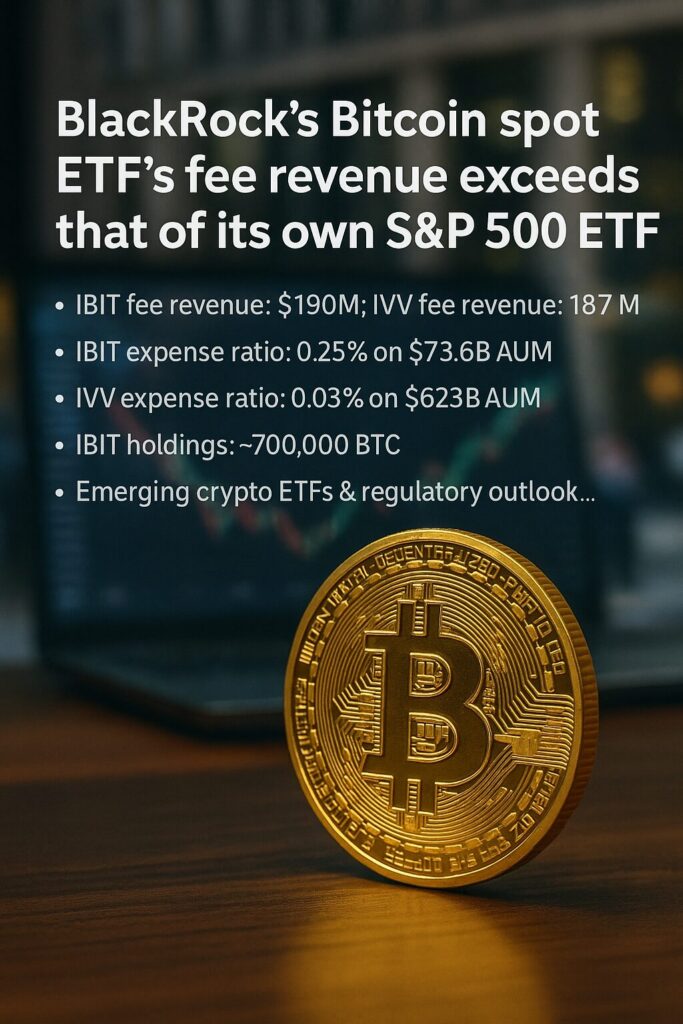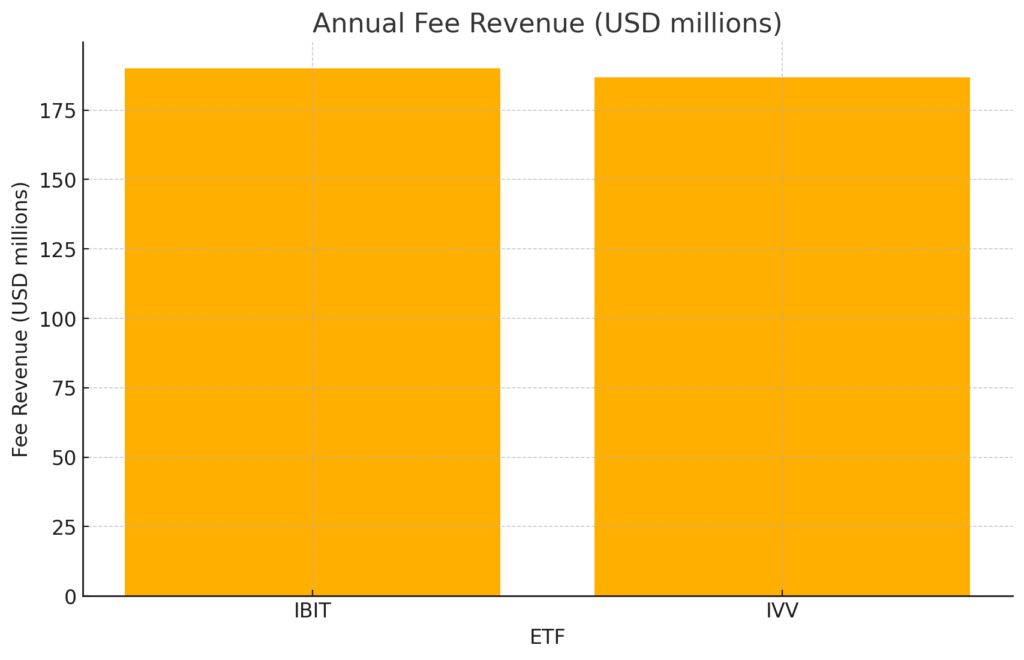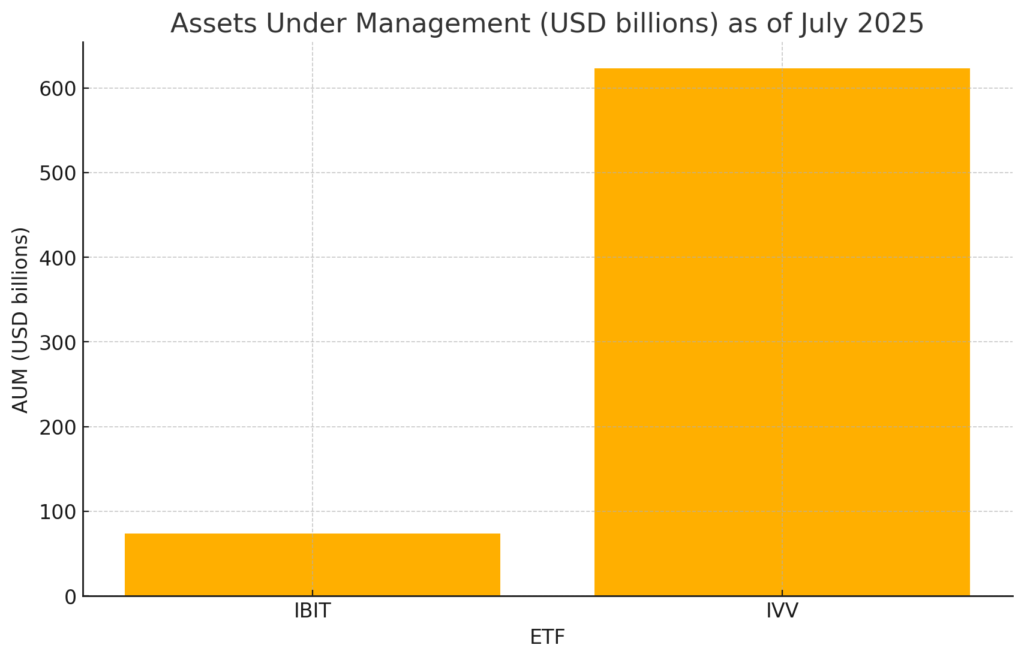
Main Points :
- BlackRock’s iShares Bitcoin Trust (IBIT) generated approximately $190 million in annual fee revenue, overtaking its flagship S&P 500 ETF (IVV) by roughly $3 million in mid-2025.
- Expense Ratios & AUM: IBIT charges 0.25% on $73.6 billion AUM, while IVV charges 0.03% on $623 billion AUM.
- Investor Demand: High allocation of institutional capital into IBIT underscores growing appetite for Bitcoin exposure despite higher costs.
- Market Position: IBIT leads in net inflows and Bitcoin holdings, holding nearly 700,000 BTC, three times more than the next-largest spot Bitcoin ETF.
- Competitive Landscape: New spot crypto ETFs (e.g., Fidelity’s FBTC, Ark/Fidelity’s ETF) and potential staking-capable products (e.g., Solana+Staking ETF) signal broader adoption.
- Regulatory Outlook: The SEC is streamlining listing standards for crypto ETFs, hinting at approvals for new spot-Ether or altcoin ETFs under Form S-1 frameworks.
BlackRock’s Bitcoin ETF Tops Fee Revenue Charts
In June 2025, Bloomberg reported that BlackRock’s IBIT generated roughly $190 million in annual fee income, surpassing BlackRock’s S&P 500-tracking ETF, IVV, which brought in an estimated $187 million over the same period . This is notable given IVV’s position as one of the largest ETFs in the U.S., ranking third by AUM at $623 billion, compared to IBIT’s $73.6 billion.
The higher revenue arises from IBIT’s fee ratio of 0.25% versus IVV’s rock-bottom 0.03%. Despite the wide gap in AUM, investors have demonstrated a willingness to pay a premium for spot-Bitcoin exposure, validating Bitcoin’s emerging role as a portfolio sleeve.
Fee Revenue and AUM Visualization
Below are visual comparisons of fee revenues and AUM for IBIT and IVV as of July 2025. Both leverage BlackRock’s global ETF distribution but attract very different investor segments:
Annual fee revenue: IBIT $190 million vs. IVV $186.9 million.

Assets under management: IBIT $73.6 billion vs. IVV $623 billion.

Institutional Demand and Flows
According to CoinGlass data, IBIT not only leads in fee revenue but also tops net inflows among spot Bitcoin ETFs. On June 30, IBIT was the only spot Bitcoin ETF registering a positive net capital influx, illustrating its dominance in drawing new money into the asset class. Over May 2025, it reached $70 billion AUM in record time, the fastest in ETF history, signaling a surge in institutional allocations after the initial launch of spot-Bitcoin ETFs in January 2025 .
Data from Bitbo suggests IBIT held roughly 696,875 BTC as of July 1, 2025, more than three times the holdings of Fidelity’s FBTC, the second-largest Bitcoin spot ETF. This positions IBIT as the largest institutional custodian of Bitcoin outside of specialized crypto exchanges.
Competitive Landscape: Beyond Bitcoin
The rise of IBIT has catalyzed competition among asset managers. Fidelity’s FBTC and Ark’s spot Bitcoin ETF, as well as thematic funds like the REX-Osprey Solana + Staking ETF (SSK) launched July 2, 2025, highlight diversification into altcoins and staking opportunities. SSK’s structure allocates at least 40% to foreign Solana ETFs and offers staking rewards, appealing to yield-seeking investors outside the Bitcoin-centric narrative. However, its expense ratio of 1.4% dwarfs IBIT’s 0.25%, potentially limiting broad adoption.
Analysts note that while staking ETFs promise annualized returns near 7.3%, they introduce smart-contract and counterparty risks that differ from Bitcoin’s store-of-value use case. Thus far, the market has rewarded pure-play spot-Bitcoin ETFs the most, as evidenced by IBIT’s leadership in flows and holdings.
Regulatory Momentum and Listing Standards
The U.S. Securities and Exchange Commission (SEC) is actively exploring ways to simplify the approval process for crypto ETFs. Recent reports indicate discussions around allowing new token ETFs to launch via a standard Form S-1 filing, bypassing individual Rule 19b-4 approvals. Such a framework would accelerate listings for spot-Ether and other token-based ETFs, potentially broadening the suite of crypto exposures available to both retail and institutional investors.
Experts believe this regulatory shift reflects growing acceptance of digital assets as asset classes worthy of traditional ETF wrappers. A more streamlined process could see spot-Ether ETFs, staking-enabled products, and multi-asset crypto ETFs emerge by late 2025, further intensifying competition among major asset managers.
What This Means for Crypto Investors
- Premium for Bitcoin Exposure: Institutional investors continue to tolerate higher fees for direct Bitcoin holdings, suggesting they view Bitcoin as a strategic portfolio diversifier, potentially on par with, or exceeding, traditional assets in a risk-adjusted sense.
- Broader ETF Ecosystem: The launch of staking and altcoin ETFs marks the beginning of a diversified crypto ETF landscape. Investors will need to evaluate trade-offs between yield opportunities and protocol-specific risks.
- Regulatory Tailwinds: Evolving SEC standards may lower barriers to entry for new crypto ETFs, signaling that investors should prepare for an expanding menu of crypto-linked investment products.
- Long-Term Outlook: As crypto ETFs mature, fee compression is likely. IBIT’s current premium may narrow as competition intensifies, similar to fee trends in equity ETFs over the past decade.
Conclusion
BlackRock’s IBIT has not only shattered records by accruing fee revenue that exceeds its flagship S&P 500 ETF but also by cementing itself as the dominant custodian of institutional Bitcoin positions. While the broader crypto ETF arena continues to evolve—with altcoin and staking products on the horizon—spot-Bitcoin ETFs remain the bellwether for institutional sentiment. Regulatory clarity from the SEC promises to further democratize access to cryptocurrency investments, setting the stage for a dynamic and diverse ETF market. Investors seeking new crypto assets or reliable sources of return would do well to monitor fee trends, AUM growth, and regulatory developments as the ETF ecosystem enters its next phase.

